Background
In the days of Black and White Television, there were two techniques to switch the output of multiple cameras onto one screen: Inlay and Overlay.
Inlay used a relatively low definition camera to look at black cut-out shapes on a bottom-illuminated screen. Some point on the step wave so produced was used as a switching signal to switch between two studio cameras. Using Inlay was standard to produce wipe effects – including iris wipes. Inlay required a specific operation to manually operate the wipes and set the switching levels. Towards the mid 1960s, “Top Of The Pops” used an engineer-designed solid state wipe machine which could generate interesting “rolling diamond” wipes between cameras.
Overlay used the output from one camera to switch from a second camera to itself. This required the background and foreground to have relatively high contrast, and the switching level to be chosen correctly: too low and the background might overlay, too high and the subject might show disappearing parts. It also requires that the main subject did not have deep shadows (that is, where part of the wave form dipped below the switching level), which meant a rather “flat” picture.
(Click on the picture below to see a larger or clearer version of this picture:
Click the “X” button (top right) to close the newly opened picture.)
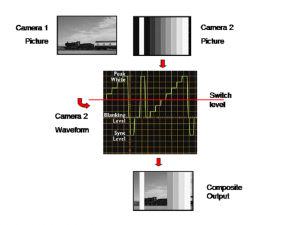
In the film industry, the equivalent to “Inlay” (in terms of the results obtained) was the used of “mattes” or masks to expose just parts of the film. This developed into the “travelling matte” where the images from the camera were used to make the mask or matte which then, in post production processing, allowed in=mages from two sources to be combined – the matte changing frame by frame as the main image changed.
This has been used in television production where the dynamic output from one source is used to switch between two other sources: the switching image may be derived from one or other of the original sources.
Colour Separation Overlay (CSO)works in a similar manner to Overlay as shown above, except that the switching potential is derived from a colour signal (not the luminance signal). Any hue can (in theory) be used for the switching signal – the trick is not to switch on any colour present in the primary subject of the camera used for the switching. The process is colloquially referred to as “blue screen” or “green screen”, these colours being frequently chosen for the overlaid camera background. In the early days of CSO, there was a time delay in the switching between the two sources, creating “fringes” around the overlaid subject.
Bernard Newnham
Dr Leah Panos is a Postdoctoral Researcher on the Arts and Humanities Research Council (AHRC)-funded project ‘Spaces of Television: Production, Site and Style’, at the University of Reading. Her research focuses on the aesthetics of Golden Age TV drama. She has written a piece about the use, by the BBC, of Colour Separation Overlay in the early days: “Stylised Worlds: Colour Separation Overlay in BBC Television Plays of the 1970s”.
She asked me to tell of my experiences, which made me skip down to the end to see who she did ask to help her with her research. I don’t see D Jervis or AJ Mitchell or other major names on the list, so I guess she didn’t pursue it too deeply, or perhaps read the credits. Her is her paper:
Click on Download PDF to see the PDF in an alternative viewer: this allows you to print or save the complete PDF document, and often makes the document easier to read.
To return to this page, use your browser’s Go Back One Page button.
Dr Leah Panos writes:
“… The BBC trialled the technique (CSO) on the comedy series “The Gnomes of Dulwich” (12 May – 16 June 1969), which required the actors to be scaled down to a ratio of 1:6, in order to appear dwarfed by their surroundings, thus avoiding the cost of building oversized sets. In November1968, CSO facilities were installed and tested for “Gnomes…” in Television Centre Studio TC8, and the technique attracted the attention of production staff across various departments. CSO equipment and instructions were rolled out more extensively across the Corporation during 1969, and demand for the facility proved to be higher than anticipated…”
ChromaKey – same thing as CSO, different name. We started calling it ChromaKey rather than CSO when the Grass Valley mixers arrived – the 300 in Pres A was first. That’s what the buttons were labelled, and trainees would know no other name.
Graeme Wall
Interesting to see “Candide” on Dr Panos’ list. This was the only major drama I worked on as the Inlay operator. It was 6 Days in the studio and I did the first three. Unfortunately I can’t remember who took over for the second 3.
Peter Hider
This subject brought to mind a Tom Baker Dr Who “Underworld” with Alan Lake (Diana Dor’s husband) . The designer built a set of caves which for reasons unknown to me was condemned by the fire service. We went ahead with it using the designer Dick Coles’ models and shooting green screen for all the action. Mike Jeffries lit it and had to give us some depth of field on these relatively small models. Mitch did electronics on the desk.
Nick Moore
On the subject of CSO and Drama.
Broadcast on the 30th Oct 1984 (part 1) and 7th Nov 1984 (part 2) was ‘Boswells London Journals’, each part ran for 2 hours and was made in the old BBC Glasgow HQ .
Every shot was CSO, and was done as a mixture of live in the studio and some recorded as travelling matte, the original image recorded on one tape and the key signal as black and white on a second and synced tape machine, all 2” VTR.
We took over the whole of BBC Glasgow for nearly a month to record the studio material, the reason for using Scotland as London couldn’t have coped.
We then spent months in the edit suits putting it together and hand drawing in mattes, using the inlay camera trollies and BBC computers for fine lines and grills (the gates and fencing).
This was one of the first occasions that CSO was used with glass, water and smoke and some shots with shadows; took ages but it worked.
I have the original broadcasts on DVDs as a transfer from S-VHS original office copy recordings.
Luckily I got credited for the Electronic (video) effects as it was put forward by BBC Scotland for an award, but couldn’t proceed as there wasn’t a category for Electronic Effects at the time.
Roger Bunce
Other entirely CSO. shows, ie. a studio full of blue or green cyc and nothing much else INCLUDE
“The Great Glass Hive*”
“The Snow Queen”
“The Light Princess”
“The Chester Mystery Plays”
“The Disappearing Schoolgirls”
“Jane at War*”
“Jane in the Desert*”
“David Bellamy’s Backyard Safari*”
“David Bellamy’s Seaside Safari*”
“Alice through the Looking Glass”
“Alice in Wonderland*”
“The Arabian Nights”
“The Ghost Downstairs*”
“Pyrates*”.
No doubt there were many others.
(* indicates those shows that I worked on.
Dave Jervis
This discussion is a bit like seeing my life flashing before my eyes… but everything has blue fringes…!
“Gulliver in Lilliput” might be worth adding to the list. .. (then I’d have worked on 9 of those programmes).
Tony Grant
I worked on “James and the Giant Peach”, although I can’t remember which crew, but my favourite production in CSO was “Orpheus in the Underground”. For one scene in this we used the escalator behind the lifts in TVC reception, and Doug Puddifoot was ‘riding’ up and down with a handheld (probably Ike 79D). The production was a musical rendition of the tale of Orpheus, and in this case he was a busker in the Underground. I was on one of the cameras providing the backgrounds, and very hard work it was too! Crew 2, with Frank Wilkins for the record.
Speaking of records, the was also a lot of CSO in Neil Innes’s series ‘Innes Book of Records’.
Roger Bunce
I did my stint as an Inlay Operator in 1968. The world was mostly still in black and white, and I was mostly sliding bits of cardboard around on a light box. But we also did some work with a newfangled idea called CSO.
I remember one experimental session with Gwillum Dann, who was then something important in the Vision Section. We were trying to get an overlay key from one of those pale, sky-blue cycs, that were common in monochrome times. Predictably, we were failing. It just wasn’t blue enough. I suggested that we needed a more primary shade. No doubt he’d already realised this, but the result was that an army of BBC painters came marching into the studio, in single file, each carrying a brush in one hand and a pot of blue paint in the other. As we watched they rapidly painted an entire studio cyc primary blue. These were the days when the BBC employed enough people to do things efficiently.
While, clearly, this was a very early experiment with CSO., my malfunctioning memory is convinced that I worked on a fully-fledged, primary-blue CSO. sequence some time before this. It was on one of David Nixon’s magic shows, at TV Theatre. David Nixon was seated on a stool, in a bar, staring incredulously at an invisible Striptease Dancer, who was performing her act in reverse, that is, she was putting her clothes ON. The Dancer was on another camera, wearing a blue body stocking, in front of a blue background. This rendered her invisible in the composite shot – until she started to get dressed. Slowly and sexily she pulled on one stocking, and then the other, so that a pair of disembodied legs were the first thing to appear. More of her figure became evident as she put on her underwear, piece at a time, and then her other clothing. Finally, fully dressed but headless, she pulled off her blue face covering and sat down beside the astonished David Nixon.
I’ve no idea why this particular scene has lodged in the memory of an impressionable young Dolly Op., but I suspect that these were the days before anyone invented Political Correctness.
Alec Bray
Black and White “Overlay” was famously used by David Nixon in one show where a ballet dancer was dancing on his hand.
Alec Bray, Graeme Wall
Dr Lanos mentions a ‘portable inlay desk. However, the Inlay desk was a permanent fixture in all TC refurbished LG studios.
There was also a portable inlay trolley used on “Dr Who” and “TOTP”, which consisted of a vidicon camera looking at a light box. Various shapes could be placed on the box to provide the switching signal. Often made out of the notorious sticky-back plastic! On “TOTP” I often used a 50p piece to produce inserts for individual faces over wide shots of the band. Add a bit of ripple glass to break up the outline and you could get some interesting effects.
Bernie Newnham
Just to see how far it’s all come since CSO days – this is David McCallum and Alice Krige on the Embankment, and it looks amazing in a number of different shots. Except that if you watch the rest of the episode (NCIS Series 12, Episode 03) you absolutely know that no-one left California, otherwise they wouldn’t have used the stock shots of London and the terrible railway station set (and actors). This scene is impressive though – an excellent piece of green or possibly yellow screen. I think the far bank is a still, with CG water for the Thames. Either that or the whole scene was filmed at an endless high tide.
(Click on the picture below to see a larger or clearer version of this picture:
Click the “X” button (top right) to close the newly opened picture.)
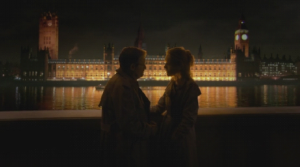
Patrick Heigham
In the film industry, into which I went after the BBC, the equivalent to “CSO” was known as ‘Blue Screen’ or travelling matte. A film mask was produced which suppressed anything blue in the shot, thus a background (or foreground) could be photographically printed in to the combined negative.
I guess that, nowadays, shooting on High-Definition video, this is much more easily achieved electronically (“Gravity” used massive amounts of ‘green screen’).
I do remember an inventive Inlay operator (using the old lightbox switch) sprinkling the plate with tealeaves, then blowing them away, so that the first image gradually broke up to reveal the second. Brilliant! This is done so easily with electronics, now, even my home edit programme (Pinnacle) offers this sort of transition.
Peter Hider
Imagine, if you will, Ancient Egypt. The King is buried with due ceremony in the Pyramid.
Next scene: French Archaeologist finding entrance to said tomb.
Tea leaves on the effects desk for Ancient Egypt, which, on cue, are blown gently away revealing the new scene as if watching stone crumbling.
Extremely effective, cheap and a pound of tea was sufficient for all required rehearsals and recording (although I think it was live). I can’t remember the production but it was early nineteen sixties, black and white. Different tea leaf sizes produced different stone crumbling appearances.
Roger Bunce
Who swept up the tea leaves?
I developed a tidier method of creating chaotic wipe patterns, using a piece of crumpled paper.
Method:
Fold up paper very carefully, or scrumple it casually.
Open it out again, allowing it to retain a heavily creased texture.
Place paper on light-box.
Turn light-box OFF.
Turn Anglepoise reading lamp (available with all good Inlay desks) ON.
Manually moving the lamp across the crumpled paper created moving patterns of light and dark, which could be used to key between shots. To make a complete wipe, start with the lamp below desk height (paper appears completely black), then move it up until it is beside the camera lens (paper appears completely white).
A range of wipe patterns could be made this way, depending on how you folded the paper. I’m sure my simple scrumpled effect was later used in the “Colditz” titles.
A fan-shaped folding created a radiating explosion of a wipe.
Ian Dow
On New Years Eve 1989 OB UNIT LO6 did its last show at a live Blondie concert at the Apollo Glasgow.
To mark the demise of the old scanner we “liberated” the maintenance EMI 2001 from the test room when nobody was looking, and rigged it in the disused balcony of the theatre. By pointing it at a monitor with its own picture we could get the “Dr Who” howl round effect, and fed this into the mixer as a wipe pattern.
What we didn’t anticipate was that the balcony bounced with Blondie’s heavy beat, so that we ended up getting a spiral wipe between cameras, twitching to the beat.
I remember Director Tom Corcoran, he of the headset clamped on top of the army hat he always wore, complete with aroma of funny smelling cigarettes, hunched over the mixer saying “We’re on the blob, I think it’s cameras 2 and 5, but don’t anybody move!”
When we emerged into the night at the end of the show the Scots had pulled off the windscreen wipers and kicked the headlights in. RIP LO6!
Bernie Newnham
One of our ex-Kingston University students ran a team at Framestore which matched the faces to the CG backgrounds.
Roger Bunce
Some images from “The Snow Queen”, Andrew Gosling and Ian Keil’s first great overlay epic, recorded at TV Centre in 1976.
(Click on each of the pictures below to see larger versions:
(Click on the pictures below to see a larger or clearer version of the picture:
Click the “X” button (top right) to close the newly opened picture.)
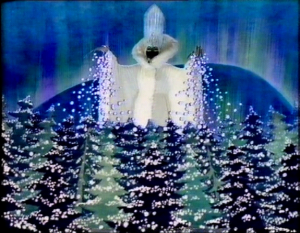
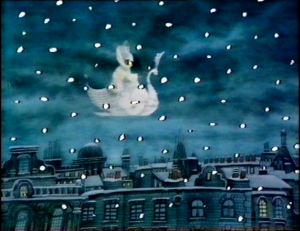
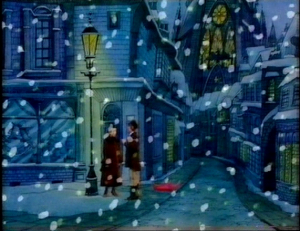
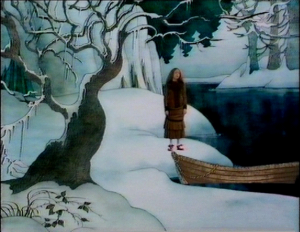
Axial Front Projection
Mike Jordan
I was very confused at the AP open day last year (the studios had very poor displays but the photos in canteen and the displays in the Theatre Foyer were good and included Brian Summers’ fake 240 line camera with blue makeup for the participants, a very good 3D demo from Ravenscourt, and a couple of television sets with big glass magnifying glass screens on front – my neighbour had one of those in the 1950s on his 9” television receiver).
There was a CSO demo and, as I stood watching, all that seemed to be behind was a sort of mirrored cloth. It seems now that they put a ring of LEDs around the camera lens (easily switched green to blue) and it is the reflection off the backing that does the switch. Hence no coloured backlight on the artistes causing fringing and difficult clipping – clever!
I then had to go on spending some time teaching visitors about what CSO was anyway!
Jeff Booth
The backing cloth is made of the same stuff they put on road signs/hi viz jackets that reflect light straight back to the source.
John Wardle
I was involved with the trials of the new technique with Danny Popkin in our experimental studio. The reflective backcloth was made by 3M and consists of tiny spheres of glass on a cloth backing. The light from the LEDs is reflected back into the lens by total internal reflection. The saving on illumination costs is staggering as getting the CSO backing lit evenly to get a clean key without any breakthrough was always difficult.
Roger Bunce
Coincidentally, the inventors of the blue LED have just been awarded the Nobel Prize for Physics.
The retro-reflective cloth is called Truematte (or similar), and is an invention from the BBC geniuses at Kingswood Warren. It appears grey to the eye, but blue to the camera (when the LEDs are turned on), and peak-white if you’re silly enough to take a flash photo of it! (Although we did manage to persuade a gullible colleague that we were now keying on grey.)
The problem for lighting was always the difficulty of flooding a large area of cyc with completely uniform light. With Truematte there is no need to light the cyc at all. Wherever the camera looks, it will see blue. The people can be lit artistically without worrying about light spill onto the cyc. And there is now much less blue light reflecting off the backing to create fringes. Replacing a grid full of soft lights with a ring of LEDs also saves on the electricity bill and on heat levels in the studio.
(Click on the picture below to see a larger or clearer version of this picture:
Click the “X” button (top right) to close the newly opened picture.)
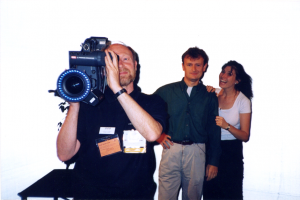
Dave Jervis
Handheld camera on a bluescreen foreground?
We actually used a similar system back in 1973 on “Moonbase 3″… Axial Front Projection screen material as a panel at the top of the set, and axial light from a camera mounted device that looked like an Autocue with a lamp instead of a monitor.
The idea was that the panel was visible as a grey panel when not being used for overlay, but it was very bad at picking up tiny but irritating boom shadows… so NOT a great success.
Roger Bunce
Even a hand-held Camera can be used on blue-screen, provided the background is a 3D computer-generated model, and the hand-held camera has a smaller B/W Camera bolted to the side, with yellow LEDs round it, pointing up at targets in the ceiling, from which the computer can read its precise location and orientation, and render the background to match.
Jeff Booth
Interestingly, “Gravity” was NOT CSO/”Green Screen”!
Read this about “Gravity”…
Then watch this…(“Box”)
“Box” explores the synthesis of real and digital space through projection-mapping on moving surfaces. The short film documents a live performance, captured entirely in camera. Basically, they projected a series of images onto a surface in order to make it appear to take on different shapes and surfaces. This sequence was done live with two FLAT screens! Amazing.
Pat Heigham
I worked on a demonstration of what was christened ‘front projection’ which used a set (cyc or masking flats) covered with Scotchlite (as was said in another message) the reflective bit of road signs.
The camera shot via a 45 degree glass, and either a slide or film projector was used to give a background, reflecting off the glass, so the camera was shooting down the axis of the projected picture.
Very effective, and we all thought it would put paid to actually filming in real foreign locations, although there were some I would have preferred not to go to!
Maurice Fleisher
I believe I am correct in saying the first use of front projection in this form was the first of the “Superman” films using a construction designed by subsequently- Academy-awarded Zoran Perisic. He was a Hungarian living here and was aided and abetted by the Staines-based Nielson Hordell company for whom I worked at the time (long after my BBC days). They manufactured film animation and printers of various types when that was the way SFX’s were made and they constructed Zoran’s design. I still have a leaflet on it somewhere.
On a Pinewood stage was a very large scotchlight-screen background through which a hole had been made to allow a controllable, rotatable pole to protrude. Christopher Reeve (Superman) wore a brace around his waist which was attached to this pole thus, being positioned in front of the screen (with his body hiding the pole), he was able to simulate flying movements with hands pointed, outstretched, rolling over etc. at all angles in sync with the front-projected background moves (up, down, zooming in, flying over houses, through clouds whatever).
Fascinating to watch.
Alec Bray, David Denness, Bernard Newnham
On “Twenty-Four Hours” (launched in 1965) in LG E we had a slide projector mounted on the camera panning head and this axially front projected slides (query via the Autocue glass) over the presenter onto a screen (and this was pre 1967). Cumbersome was not the word to describe it!
Presenters included Cliff Michelmore and Michael Barrett.
Sound wise it was a total disaster as the presenter was standing at the focal point of the parabolic reflector that was the screen. Always sounded like a bathroom.
Dave Buckley
Two films that definitely use FAP or AFP depending on which you like, were “2001” and “Battle of Britain”.
Also “Horizon” did a programme on the method with Richard Baker presenting.
Motion Capture
Dave Buckley
Now for a story from TV Training — sometime in the mid-1970s our then small B/W training studio was booked by none other than Dr. Jonathan Miller for a series of experiments concerned with how the brain perceives images if there isn’t that much information available.
What Jonathan wanted was a completely dark studio with pin points of light showing on a person so that the eye and brain had to interpret what was happening. I suggested a variation of FAP in that, instead of a slide projector/film projector and a half silvered mirror, we put a 1k lamp next to the camera, pull the black cyc round, dress Jonathan in a CSO blue boiler suit which also had a hood, and stick small squares of Scotchlite onto the boiler suit at arm and leg joints and a few other places.
After setting up the studio, we had a look on camera and all we could see was the pin points of light as Jonathan moved around the studio – it was very clear as to what he was doing.
For another experiment, half the squares were removed to see what our perception was of the movements. Apparently, there are some brain disorders whereby the person will only (say) eat food from one side of a plate at mealtimes, and when this was pointed out to them, the reply would be to the effect, that the remainder was not their food.
I am aware that the above method of mapping movement using reflective stick on squares is now commonplace, but back in the 70s it certainly wasn’t.
In all a very interesting day and Dr. Miller went away very pleased together with a tape of the experiments..
Pat Heigham
That sounds like a fore-runner of motion control capture?
It amazes me, when hearing of what those of us in the BBC were playing with – got taken up and adapted by the Film Industry.
When I left to enter the world of film, when those folks learnt from where I had come, I was told to wash my mouth out. TV was viewed as a threat to those working in film.
One of my early films was “Fiddler on the Roof “ – a massive playback situation. Not only did I alter the way the P/B was delivered to the artistes – formerly with a huge horn blasting it out – no, I instituted a chain of line source speakers, each working at a much lower level, but also I discovered that the playback tapes would need various versions of orch/vocal ratio. Bugger that! I was used to 2-track playback off a TR90! Problem – it had to sync with the cameras.
With another engineer, I built two twin-track Nagras – the stereo Nagra was about 3 years away, but we needed a sync machine, and having been brought up with two track playback at the BBC (Orch and Vocal separate, so the relative levels could be adjusted simply on the pots) I wasn’t about to make up loads of tapes with different ratios!
ChromaKey and Ultimatte
Dave Plowman
ChromaKey may have been a trade name But it does flow off the tongue rather better than Colour Separation Overlay.
Did the Beeb ever use Ultimatte? That was a commercial device which Thames TV bought – and in the hands of a skilled operator (ie only one or two) it could produce spectacular results. It was said to be fiendishly complicated, with many knobs to tweak, any of which merely made things worse.
Thames TV made “L’Enfance du Christ” using Ultimatte which won an award or two (the reason it was made).
Jeff Booth
The only time I know the Beeb used Ultimatte was for the recording of the opera “New Year” by Sir Michael Tippett. Music and Arts (Dennis Marks). It was TC3 or 4 and around 1993. Edited at Framestore (when they were in Great Pultney Street (next to Soho 601)). All recorded component on Beta SP and delivered on D1.
Post Production CSO
This seems rather like an electronic version of travelling matte.
Dave Jervis
Clive asked
“…When was it that we first actually started keying-in in post-production from generated B-Y signal recorded in studio?…”
I am aware of several attempts to key off VT in the 1970s and early 1980s by decoding the video (which tended to give a very poor quality key) or by recording a separate B-Y as a luminance on a second VT (costly in both equipment and time synchronising machines, but it could give good results).
As far as I am aware, it was only after good quality component recording arrived with Betacam SP or M II (about 1987) that real off tape keying became straightforward.
Jeff Booth
Very rarely was CSO done in post (for the reasons Dave has given)
The biggest problem was that the VT machine supplying the key had to be fed with an early PAL reference to compensate for the delay through the PAL decoder (otherwise the key was late relative to the fill).
Not much Beta SP as getting a B-Y from a studio was messy (tie lines etc.)
Ian Hillson
When Studios (Limited Resorces, as one wag likes to call the BBC Resources Ltd company) installed VT machines in the studio apparatus rooms they rather shot themselves in the foot by using D3 format. It was only when DigiBeta came along that CSO and other effects could start to happen properly in Post.
BBC News used decoded CSO with varying degrees of success from the nineteen seventies, particularly on the output of College Mews studio opposite Westminster. This was a one camera remote unmanned studio built in the Bishop’s Bomb Shelter – all the CSO backings were at TVC on 35mm slides. The blue flattage could have curtains pulled across (by the presenter!) if he came in wearing a blue tie – “…but it’s only got a little bit of blue in it….”
Please also see “VTR Formats.



